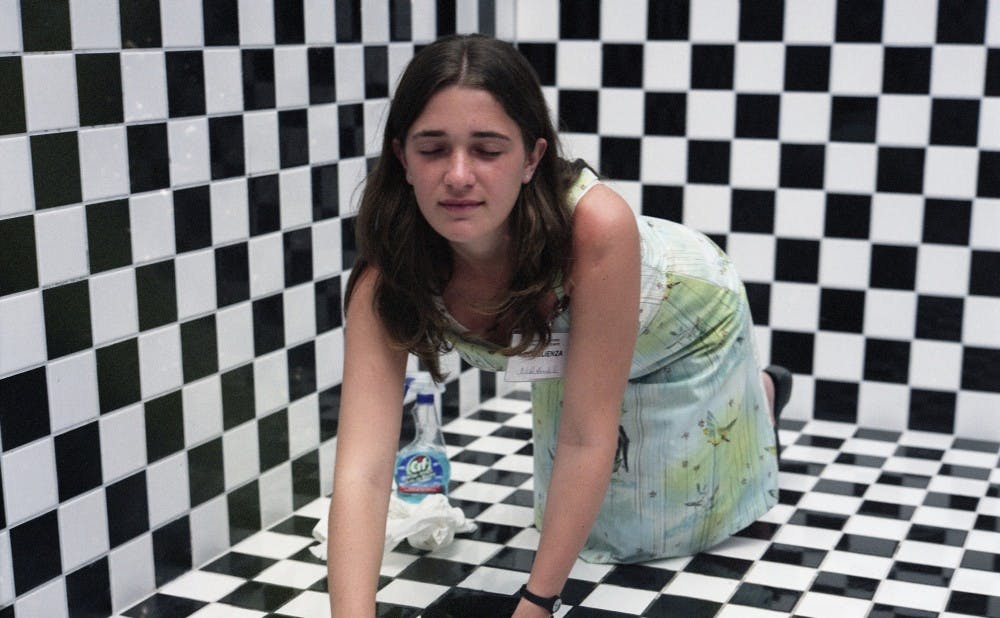Who do we allow to dream? Whose dreams do we privilege, and whose thoughtful roundabouts do we fail to consider?
These questions are based in the identity of the individual, requiring us to be conscious of the conscience of another. And perhaps it is the traditional academic renderings of labor, as well as the difficulty it takes to dwell on our own privileges, that makes many of us unwilling to thoroughly extend these questions to labor and workers. But in “Workers Dreaming,” a collection photographed and curated at the turn of the century, artist Elin O’Hara Slavick asks us to do just that. Her collection was — and still is — a welcoming antidote to conceptions of class based in the amorphous, conformist connotations of terms like “labor.”
Slavick, a professor and conceptual photographer at University of North Carolina-Chapel Hill, does not consider the collection to be part of her truly serious, academic body of work. She conceived of the project while working as an assistant to Joel Sternfeld on his “On This Site” portfolio. While traveling with Sternfeld across the country, she was struck by the individuality, personality and aesthetic of the many workers they came across, who are embedded in our day-to-day lives as janitors, waitresses and cooks as well as installed as a very feature of the American landscape, as truck drivers, construction workers, policemen and gardeners.
“I have been waitress and a chambermaid and a cocktail waitress, and I’ve worked in a record store and cleaned people’s apartments,” Slavick said. “Now I’m a professor, and I notice that there is a difference in class, there is elitism. ... What strikes me is how frequently these workers are ignored or treated badly.”
Slavick’s work itself was not particularly labor intensive, with her photos requiring a mere handful of seconds to take and always taking advantage of whatever natural lighting was available. Her photography was intuitive, its focal point being the closed eyes of a subject who denies the viewer their attention and creates their own hermetic, humanistic space.
“By having them close their eyes, you’re empowering them because they’re allowed to be in their own space, and they can be thinking about whatever they want,” Slavick said. “It’s just them, in their workplace.”
Although Slavick’s exhibit is more of a taste than a full, encapsulating experience, it is one that is developed, rich and timely. It is one that was needed when it was first conceived, and one that is equally needed now. It was not until the '90s that individual narrative was extended to the working class in academic discourse. “Working class consciousness” was no longer an understanding that merely arose out of joining the labor force. Rather, it is a component of one’s upbringing and culture, and it constitutes one’s identity from the day one is born. Third-wave feminist discourse brought about new considerations of labor as part of culture, “common sense” understanding and individual upbringing.
Class awareness is as much an identity as race, gender or religion, and it is equally constructed through an individual’s interaction and discourse with others. Karl Marx brought us the nebulous “proletariat,” and third-wave feminism brought us the inverse: individual identity as a working-class laborer. Slavick’s subjects are a visualization of the latter: by refusing us their time and attention, we are reminded of their own agency.
Slavick’s exhibit, which is on view at the Kenan Institute for Ethics, manages to reference the academic nature of the space in which it is situated. It serves as a reminder of agency in an academic space that bustles with faculty, students and workers alike, a space that constitutes a small corner of the very ivory tower that has historically denied individual laborers that agency.
The images themselves are striking, and the power imbalance they imply directly implicates the viewer. The service workers who frequently wait upon us — the waiters, coffee girls, cooks, valets and drivers — are now laying claim to their own moment, their own humanity. We are now the ones waiting for them, giving them our attention. “No, you look at me,” they seem to be saying.
Though Slavick’s photographs were made nearly 20 years ago, they still maintain relevance today. Many of us see the people in these photographs in our day to day lives, and they feel distinctly familiar. Though some photographs do show their age and manage to have an air of nostalgia — particularly one image of a Torero’s waiter from the early 2000s and another of three African-American boys selling flavored ice — the vast majority feel all too recent. One image in particular, of a gardener blowing leaves on the UNC Chapel Hill campus, appears as though it could have been taken this very year.
The timeless quality of the photography is somewhat unexpected, given what is popularly known about the speed of automation and the veracity with which it is meant to take our jobs. But economic data suggests the opposite: Although jobs may change sectors, they are not lost, and the number of service workers is only expected to increase within the next couple of decades. Slavick’s photography is as much a treatise on the recent past as it is an indicator of the future. Service workers will not disappear. Their humanity, as well as the attention that should be paid to it, will not become an archaic issue. Workers share our dreams, and they share our agency, too.
Correction: A previous version of this article referred to Joel Sternfeld's project as "Ominous Sites," not "On This Site." The Chronicle regrets the error.
Get The Chronicle straight to your inbox
Sign up for our weekly newsletter. Cancel at any time.

